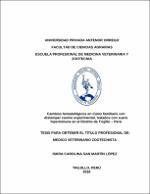Cambios hematológicos en Canis familiaris con distemper canino experimental, tratados con suero hiperinmune en el distrito de Trujillo - Perú

Ver/
Descargar
(application/pdf: 753.9Kb)
(application/pdf: 753.9Kb)
Fecha
2017Autor(es)
San Martín López, Iskra Carolina
Metadatos
Mostrar el registro completo del ítemResumen
La presente investigación tuvo como propósito evidenciar los
cambios hematológicos en cachorros con distemper canino, tratados con
suero hiperinmune, mediante el uso del hemograma completo, para lo cual
se infectaron con la enfermedad un total de 9 especímenes, los mismos
que fueron diagnosticados mediante la prueba de inmunocromatografía,
luego se dividieron en dos grupos de 8 y 1 pacientes, de los cuales un
grupo no recibió tratamiento con suero hiperinmune (grupo control) y el
otro grupo si recibió el tratamiento con el suero hiperinmune a dosis de 2
ml. por kilogramo de peso vivo vía intramuscular profunda (grupo tratado)
los días 10, 11, 12 y 13 post infección. Los hemogramas de los pacientes
fueron tomados a los 5, 10, 15, 20, 22, 24 y 26 días post infección. El 100
% de los pacientes del grupo control fallecieron a partir del día 15 al 20
post infección; mientras que los pacientes del grupo tratado sobrevivieron
hasta el último día de evaluación (día 26). Por lo que se concluye que el
suero hiperinmune logró una sobrevivencia a la enfermedad del 100 %. The purpose of the present investigation was to show the
hematological changes in puppies with canine distemper, treated with
hyperimmune serum, by means of the use of the complete blood count,
for which a total of 9 specimens were infected with the disease, the same
ones that were diagnosed by the test. of immunochromatography, then
divided into two groups of 8 and 1 patients, of which one group received
no treatment with hyperimmune serum (control group) and the other
group received treatment with hyperimmune serum at a dose of 2 ml.
per kilogram of live weight via deep intramuscular (treated group) on
days 10, 11, 12 and 13 post infection. The hemograms of the patients
were taken at 5, 10, 15, 20, 22, 24 and 26 days post infection. The 100%
of the patients in the control group died from day 15 to 20 post infection;
while the patients of the treated group survived until the last day of
evaluation (day 26). So it is concluded that the hyperimmune serum
achieved 100% survival to the disease.
Palabras clave
Colecciones
- Veterinaria y Zootecnia [219]

